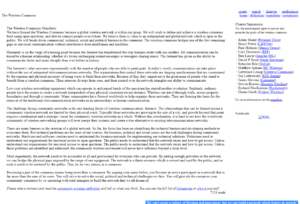2003 - The Wireless Commons Manifesto - The Wireless Commons

Texto
The Wireless Commons
The Wireless Commons Manifesto
We have formed the Wireless Commons because a global wireless network is within our grasp. We will work to define and achieve a wireless commons built using open spectrum, and able to connect people everywhere. We believe there is value to an independent and global network which is open to the public. We will break down commercial, technical, social and political barriers to the commons. The wireless commons bridges one of the few remaining gaps in universal communication without interference from middlemen and meddlers.
Humanity is on the verge of a turning point because the Internet has transformed the way humans relate with one another. All communication can be traced to a human relationship, whether it's lovers exchanging instant messages or teenagers sharing music. The Internet has given us the ability to communicate faster and more cheaply than ever before in history.
The Internet's value increases exponentially with the number of people who are able to participate. In today's world, communication can take place without the use of antiquated telecommunications networks. The organizations that control these networks are limping anachronisms that are constrained by the expense and physical necessity of using wires to build their networks. Because of this, they cannot serve the great mass of people who stand to benefit from a wireless commons. Their interests diverge from ours, and their control over the network strangles our ability to communicate.
Low-cost wireless networking equipment which can operate in unlicensed bands of the spectrum has started another revolution. Suddenly, ordinary people have the means to create a network independent of any physical constraint except distance. Wireless can travel through walls, across property boundaries and through a community. Many communities have formed worldwide to help organize these networks. They are forming the basis for the removal of the traditional telecommunication networks as an intermediary in human communication.
The challenge facing community networks is the one limiting factor of wireless communication: distance. The relationships that can be formed across a community wireless network are limited by their physical reach. Typically these networks are growing to the size of a city, and growth beyond that point requires coordination and a strategic vision for community wireless networks as a whole. Without this coordination, it is hard to see how the worldwide community of wireless networking groups will ever merge their systems and create a true alternative to existing telecommunication networks.
There are many barriers to the creation of a global network. So far, the focus has been on identifying the technical barriers and developing methods to overcome them. But technical problems are the least of our worries, the business, political and social issues are the real challenges facing community networks. Hardware and software vendors need to understand the business rationale for implementing our technical solutions. Politicians need to understand our requirements for universal access to open spectrum. The public needs to understand that the network exists and how to get access. Unless these problems are identified and addressed, the community wireless movement will never have influence beyond a local level.
Most importantly, the network needs to be accessible to all and provisioned by everyone who can provide. By adding enough providers to the network, we can bridge the physical gaps imposed by the range of our equipment. The network is a finite resource which is owned and used by the public, and as such it needs to be nurtured by the public. This, by its very nature, is a commons.
Becoming a part of the commons means being more than a consumer. By signing your name below, you become an active participant in a network that is far more than the sum of its users. You will strive to solve the social, political and technical challenges we face. You will provide the resources your community consumes by co-operating with total strangers to build the network that we all dream of.
Please take a moment and read the community wireless definition and tell us what you think. You can see the full list of signatories or sign it yourself.
"We can't create a culture of freedom and innovation, but we can build a network which fosters its growth."
Contexto
The Wireless Commons Manifesto es un documento publicado en el año 2003 por personas que se encontraban experimentando, implementando y creando estrategias como las redes wifi para resistir y proveer alternativas al dominio en la infraestructura de telecomunicaciones por parte de las industrias (1). Según Cory Doctorow, uno de los firmantes del manifiesto, éste documento tenía por objetivo sentar las bases y definir a lo que se convertiría en el proyecto The Wireless Commons, el cual buscaba organizar la defensa y la interconectividad de los proyectos inalámbricos comunitarios, de la misma forma, es una iniciativa específica que ha desarrollado una definición útil de una Red Inalámbrica Comunitaria, y las características que esta debería tener (2). El manifiesto fue editado en el libro The Wireless Spectrum: The Politics, Practices, and Poetics of Mobile Media (2010) publicado por Barbara Crow, Michael Longford y Kim Sawchuk (1).
Aparece en Varios autores. (2016). Manifestos For The Internet Age v0.8. M.Schmalstieg, B. Crevits, V.Kruug (Eds). Greyscale Press.
https://github.com/greyscalepress/manifestos/tree/master/content/manifestos
Autoras
El manifiesto fue firmado por Adam Shand (Personal Telco), Bruce Potter (CAWNet), Paul Holman (Shmoo Group), Cory Doctorow (EFF), Ben Laurie (Apache-SSL), David P. Reed (Open Spectrum), Schuyler Erle (NoCat), Matthew Asham (BC Wireless), Lawrence Lessig (Creative Commons), Jon Lebkowsky (EFF-Austin), James Stevens (Consume), Steven Byrnes (Houston Wireless), Richard MacKinnon (Rocksteady) y Duane Groth (Sydney Wireless) (3).
Archivo
Archivo:The Wireless Commons Manifesto The Wireless Commons.pdf
Fuentes
(1) Crow, B., Longford,M., y Sawchuk, K. (eds.) (2010). The Wireless Spectrum: The Politics, Practices, and Poetics of Mobile Media . Canada_ Toronto University Press. Disponible en: https://books.google.com.mx/books?id=UpcVHDbEgB4C&pg=PT116&lpg=PT116&dq=The+Wireless+Commons+Manifesto&source=bl&ots=_ZQfZz0PA0&sig=ACfU3U1tm-zCTf4L3nUOQRn-gJhsPp1VYQ&hl=es&sa=X&ved=2ahUKEwiS7-qZvr7gAhVPT6wKHSWXBTIQ6AEwA3oECAcQAQ#v=onepage&q=The%20Wireless%20Commons%20Manifesto&f=false
(3) https://sindominio.net/metabolik/alephandria/txt/wirelesscommons.html
Enlaces
Primera edición: https://web.archive.org/web/20070212204930/http://www.wirelesscommons.org/node.php?id=2&PHPSESSID=678ca14c1113d47b88a63010e890a505
URL: https://personaltelco.net/wiki/WirelessCommonsManifesto, https://sindominio.net/metabolik/alephandria/txt/wirelesscommons.html
Wayback Machine: https://web.archive.org/save/%20https://personaltelco.net/wiki/WirelessCommonsManifesto, https://web.archive.org/web/20190221000643/https://sindominio.net/metabolik/alephandria/txt/wirelesscommons.html